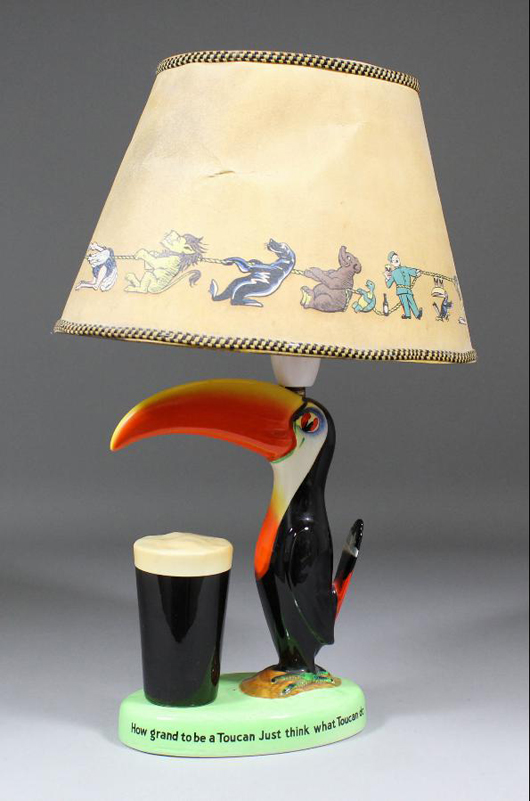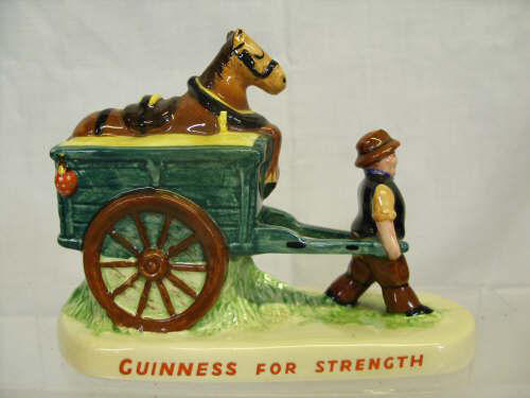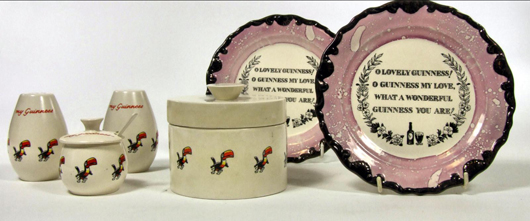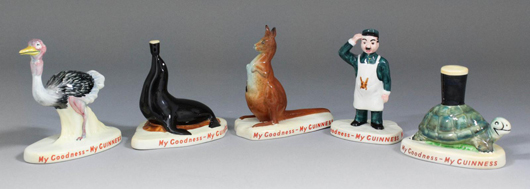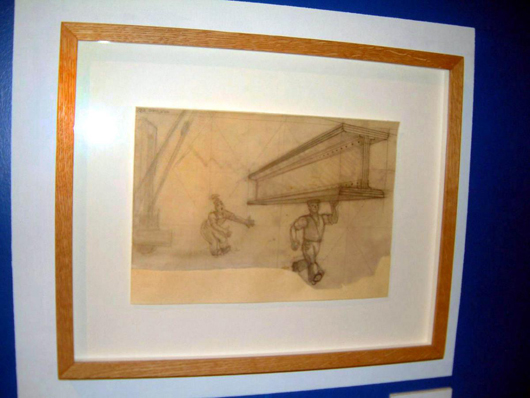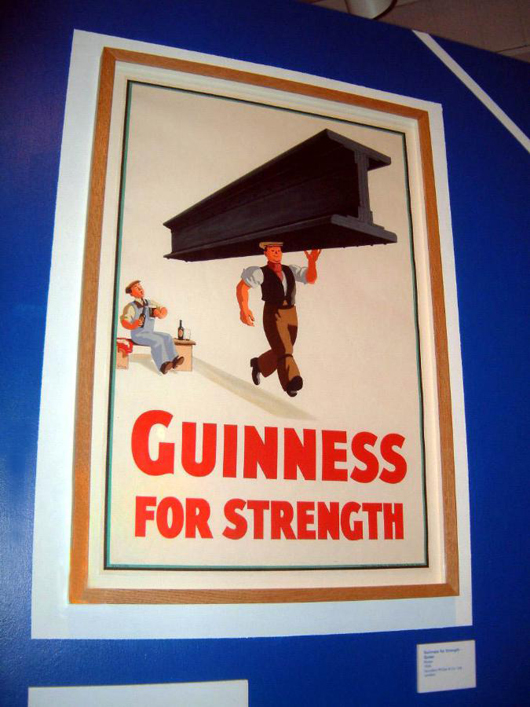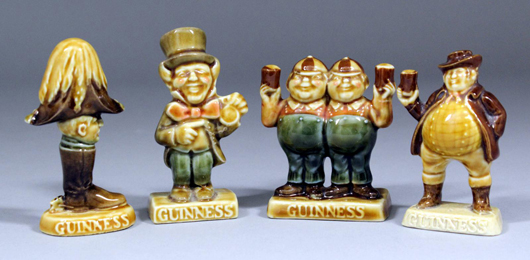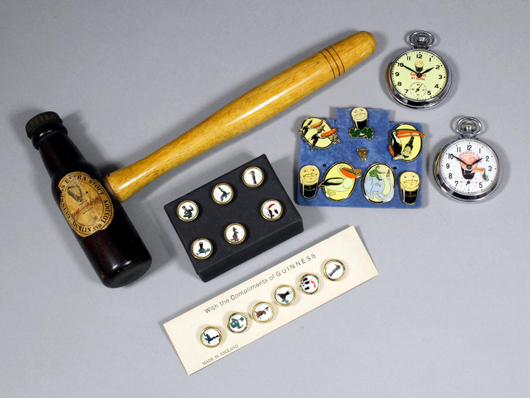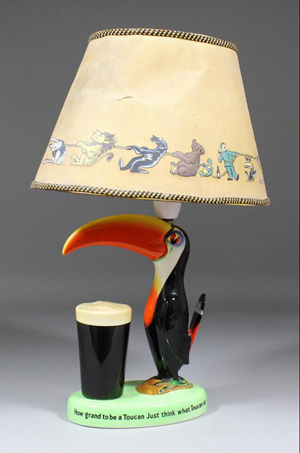
LONDON – The Business Manager (Mrs. P) went to Dublin and, to coin that well-known t-shirt phrase, all I got was a lousy bar of chocolate. Oh, and a bag of roasted peanuts, although to be fair, both were flavored, oddly enough, with the distinctive taste of the world’s most famous stout. I prefer it out of a glass.
No trip to the fair city would be complete without a visit to Arthur Guinness’ St. James’s Gate brewery. It’s the first stop on the hop on/off tour bus, but it serves the world’s most expensive pint: the 18 euro entry (£14.32, $23.73) gets you a “free” one. Worse still, she felt not enough is made of its history or the great advertising campaigns that put the brand where it is today.
So, by way of redressing the balance, I thought I’d raise a glass in celebration of the raft of Carlton pottery toucan pub lamps, zoo animals, pub jugs and ashtrays we collectors cherish and the man from whose imagination it all sprang: the graphic artist John Gilroy. (1898-1998).
John Thomas Young Gilroy (1898-1985) was born in Whitley Bay on Tyneside into a family of eight children. His father, John William, was a marine landscape painter and technical draughtsman, and by the age of 15, young John was contributing artwork to the local newspaper, the Newcastle Evening Chronicle.
He subsequently won a scholarship to art school at Durham University, but on the outbreak of World War I, he joined the Royal Field Artillery, serving in France, Italy and Palestine.
After the war, Gilroy accepted a place at the Royal College of Art, and after winning several more scholarships to further his education there, he was invited to stay on to teach.
His introduction to Guinness began in 1925, when he joined the advertising agency S.H. Benson Ltd.
Gilroy’s versatility and technical skills were remarkable. He had the ability to flit with ease from intricate pen-and-ink drawings – as featured in the Guinness Doctors’ Christmas books of the 1930s (now highly prized by collectors) – to the expansive canvas of the poster.
He was as happy painting murals as he was greeting cards, but he also had a reputation as an accomplished landscape and portrait painter.
His work was exhibited regularly at the Royal Academy, and his sitters included several members of the Royal Family, Sir Winston Churchill and Rupert Guinness, Lord Iveagh II.
However, Gilroy will be best remembered for his Guinness posters and press advertisements, of which he created well over 100 in a 35-year period.
Among them are two of the most enduring advertising images ever crafted: the “Guinness for Strength” workman casually carrying a steel girder on his head, and the impudent sea lion making off with the zookeeper’s pint in the “My Goodness, my Guinness” poster.
The inherent humor was, of course, achieved by simple exaggeration: after supping a glass of Guinness, you could apparently lift huge metal girders, pull a horse along in a cart or chop down a tree with the single blow of an ax.
The antics of the harassed zookeeper and his mischievous charges are said to have been inspired by a visit Gilroy made to a Bertram Mills Circus in Olympia, although his sketches and studies of the various animals were made at London Zoo.
The red-faced mustachioed zookeeper was apparently a caricature of the artist himself.
The first poster in the highly sucessful campaign was launched in 1935, and featured a sea lion making off with a pint of Guinness perched on its nose.
It provided the basis for innumerable variants which saw the hapless keeper pitting his wits against kangaroos, ostriches, pelicans, gnus and lions, all determined to hijack his precious pint.
An interview for Guinness Time, the company’s house magazine, which appeared in 1952, gave an insight into Gilroy’s humor.
He said: “The hoardings are the Museum of the Masses. They hoard the art treasures of the man in the street. But the man in the street is usually in a hurry to catch a bus or to avoid being caught by a bus; he has no time for contemplation.
“My posters, therefore, are a kind of aesthetic meal in a minute. A man may whizz by on a motorbike or in a Black Maria and yet absorb one of my posters. Why? Because my posters are like a certain self-made man – they have no background.”
For pottery manufacturer Carlton, the opportunity to immortalize Gilroy’s characters was heaven sent. The pottery was established in 1890 following the partnership forged between James Frederick Wiltshaw and J.A. and H.T. Robinson.
The business began producing decorative earthenware at their factory, the Carlton Works in Copeland Street, Stoke-on-Trent.
The firm was first registered in 1893 and the trade name Carlton Ware was adopted in the following year. However, it went into receivership in 1931 and merged with Birks, Rawlins & Co. Ltd. the following year.
Renamed Carlton Ware in 1957, the firm was purchased first by Arthur Wood & Son (Longport) in 1966 and then by County Potteries in 1987, going into voluntary liquidation in 1991.
The name then remained dormant until 1997 when Francis Joseph acquired it together with a small number of molds and a few preproduction models, which continue to be made.
Guinness turned to Carlton in 1955 and the Toucan bar lamp was the first of a steady stream of figures and model groups to roll off the production line.
Today, the lamp changes hands for up to £500 … if it’s genuine. Fakes of the same thing, priced around £75-£100, are in truth worthless. The giveaway is the fake has no hole in the bird’s head for the light fitting, while the frothy head on the pint of Guinness is much shallower than the original.
The drayman pulling his horse and its cart is one of the rarest Carlton figures, but again fakes are commonplace. The original has a small figure of a ladybird climbing up the side of the cart, but not the fake.
Fake zoo figures include the ostrich, which has a white face and a black lump in its throat where the glass is lodged – both should be pink; the tortoise with a froth-free glass on its back and a missing foot; and the penguin, which lacks the ”Draught Guinness” lettering on its chest and the wrong color beak and eyes.
So be careful out there.

ADDITIONAL IMAGES OF NOTE
